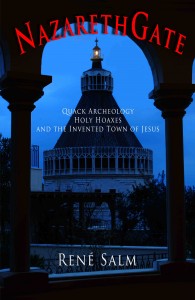 NazarethGate by René Salm furnishes readers with far more than the published archaeological evidence for the existence of Nazareth at the supposed time of Jesus. In taking up the task of mastering the research literature on the archaeology of Nazareth Salm has found that archaeologists well-known for their proclamations of finds that are relevant to our understanding of Jesus have a track record of questionable methods and reliability. Hence the pun on the Watergate scandal in the title as well as the subtitle: quack archeology, holy hoaxes, and the invented town of Jesus. Salm has done the work to earn the right to make these judgements.
NazarethGate by René Salm furnishes readers with far more than the published archaeological evidence for the existence of Nazareth at the supposed time of Jesus. In taking up the task of mastering the research literature on the archaeology of Nazareth Salm has found that archaeologists well-known for their proclamations of finds that are relevant to our understanding of Jesus have a track record of questionable methods and reliability. Hence the pun on the Watergate scandal in the title as well as the subtitle: quack archeology, holy hoaxes, and the invented town of Jesus. Salm has done the work to earn the right to make these judgements.
In my previous post I touched on Salm’s exposure of the “less than optimal” work of Ken Dark. (Compare also A Critique of Ken Dark’s Work at the Sisters of Nazareth Convent.) There is much more. But here I am pausing to set out for easy reference a very general summary of the archaeological evidence for Nazareth. That is, what follows is taken from the scholarly published literature as distinct from unverifiable popular press reports. The former are testable; the latter — even if quoting opinions of certain archaeologists — are not.
Salm is able to point to the apparent influence his earlier book, The Myth of Nazareth, has had on the chagrined re-writing of some of the claims made about the archaeological evidence. Hopefully this new work will help raise a more public awareness of the tendentiousness (even incompetence) of the claims of some of the archaeologists who press claims for evidence that Nazareth was the home of Jesus.
From the Bronze Age to Roman Times
Continue reading “Nazareth, General Overview of the Evidence”
